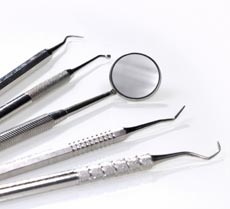5 Habits That Lead to Plaque on Your Teeth
Plaque. Since childhood, we’ve been trained to resist that dreaded enemy of teeth. Regular brushing and flossing are sure bets for dental health. What else could you be doing — or avoiding — to keep plaque off your knockout smile?
 “Keeping plaque off your teeth isn’t complicated, but consistency is key,” says Richard Price, DMD, spokesman for the American Dental Association. “Good habits make for healthy teeth — for most people, it’s that simple,” says Price.
“Keeping plaque off your teeth isn’t complicated, but consistency is key,” says Richard Price, DMD, spokesman for the American Dental Association. “Good habits make for healthy teeth — for most people, it’s that simple,” says Price.
What Is Tooth Plaque?
Plaque is a sticky mix of bacteria and the substances they secrete. Bacteria produce adhesive chemicals called mucopolysaccharides. The bacteria then live in this film on teeth, called a biofilm.
At first, this slimy layer is fragile and easily removed by tooth brushing. “Think of the film on a fish tank wall. It’s easy to wipe off with a washcloth, if you’re vigilant,” says Price.
And if you’re not? The bacteria in tooth plaque are free to release acids that damage tooth enamel. Regular acid assaults on enamel can wear holes in teeth, commonly called cavities.
If left alone, plaque buildup also gradually hardens, creating tartar or calculus on your teeth. “Tartar is petrified plaque,” says Price. “Once it’s there, you need a dentist’s help… tartar can’t be brushed off.” Tartar above the gum line also contributes to gingivitis, or gum disease.
The secrets to avoiding plaque buildup aren’t so secret. You’ve probably been hearing most of them since before you lost your baby teeth. But bad habits have a way of sneaking up on us. Make sure you’re pushing back against plaque by avoiding these five bad habits for tooth health.
No. 1: Not Brushing Regularly
No one else might notice if you don’t brush your teeth twice a day, every day. But your teeth will. “Plaque is a little like bees in the summertime,” offers Price. “One or two won’t really bother you, but if you let them build a beehive in the backyard, you’ve got a problem.” Brush your teeth gently twice a day, using a fluoride-containing toothpaste. The exact technique isn’t so important as concentrating to make sure you’re softly brushing all the surfaces of your teeth.
No. 2: Not Flossing Daily
Brushing doesn’t reach the spaces between teeth, but plaque does. A simple daily flossing between teeth clears away plaque before it can cause damage. “Flossing also cleans plaque at the gum line, another area that brushing doesn’t reach,” says Price. If left alone, plaque past the gum line can lead to periodontal disease. If you just can’t stand flossing your teeth, consider using one of the many other ADA-approved products to clean between your teeth daily.
No. 3: Avoiding the Dentist
Even if you brush and floss your teeth daily, you’ll miss some plaque. Over time, that plaque hardens into tartar that needs to be removed at your dentist’s office. Yet more than a third of people surveyed haven’t seen their dentist in more than a year. “Even dentists don’t like to go to the dentist,” jokes Price. But studies show that in general, people who neglect regular dentist visits get more cavities and have a higher chance of losing their teeth. Once a year teeth cleanings are considered the minimum. Twice a year teeth cleanings may be better for many people. “Most dentists recommend twice a year cleanings or more,” according to Price.
No. 4: Neglecting Nature’s Toothbrushes
Long before toothbrushes and fluoride toothpaste existed, certain foods played a role in keeping plaque off our teeth. “Eating crunchy vegetables or fruits with the skin on can scrub off plaque,” explains Price. Carrots, apples, cucumbers, and many other raw fruits and vegetables are teeth-friendly, despite the sugar they contain. In addition, eating a diet high in fruits and vegetables and low in processed foods helps protect you from obesity, heart disease, and cancer.
No. 5: Indulging Your Sweet Tooth
Bacteria love simple carbohydrates like sugar. Eating candy or drinking sugary soft drinks lets sugar stick to our teeth, giving bacteria something to munch on. As the bacteria create a film of plaque, they digest sugar into acid, which damages teeth. “All sugary candy, and most junk food in general, contribute to plaque formation,” warns Price. “High-sugar foods or drinks that are also soft or sticky are especially problematic. Sugary soft drinks might be about the worst thing you can put on your teeth,” says Price.
Avoiding these five bad habits can help you keep plaque in check (and keep your teeth). There are other steps you can consider to prevent plaque, tartar, and cavities, too:
- Sealants. The pits and fissures on molars can be difficult to keep clean in some people, even with good dental care. Dental sealants are a clear plastic coating that covers the tooth surface, barring bacteria and acid from entering. Sealants are safe and effective in blocking plaque and preventing tooth decay.
- Mouth rinse. Some people may benefit from adding a therapeutic mouth rinse to their daily routine. Several ADA-approved mouth rinses with fluoride have been shown to help prevent plaque and tooth decay. No mouth rinse can substitute for brushing and flossing, however.
“No one’s teeth can stay plaque-free 24 hours a day, it’s just not possible,” says Price. But good habits over a lifetime will help you beat back plaque and save your smile.
